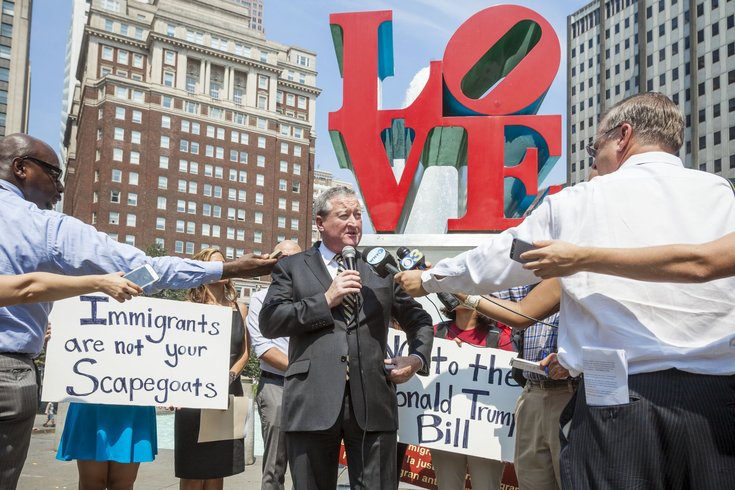
January 25, 2017
 Thom Carroll/PhillyVoice
Thom Carroll/PhillyVoice
Jim Kenney advocates for "sanctuary city" policies during a rally at LOVE Park in July 2015.
President Donald Trump moved to strip federal funding from so-called sanctuary cities, like Philadelphia, as he signed executive orders aimed at tightening the nation's immigration controls on Wednesday.
The signing confirms earlier reports that the Trump administration will take a tough stance on sanctuary municipalities, which have policies preventing local law enforcement officials from coordinating with federal immigration authorities unless they have an arrest warrant.
Trump also signed an executive order aimed at jumpstarting construction of a wall along the U.S.-Mexico border.
"Beginning today the United States of America gets back control of its borders," Trump declared during a visit to the department of Homeland Security. "We are going to save lives on both sides of the border."
Despite an executive order aimed at sanctuary cities, Mayor Jim Kenney said the city has not intention to reverse its policy.
.@PressSec says Trump administration will "strip federal grant money from sanctuary states and cities" that harbor undocumented immigrants. pic.twitter.com/vAOhL9V7cs
— CBS News (@CBSNews) January 25, 2017
His spokesperson, Lauren Hitt, said in a statement that since "today’s (executive order) was simply a directive and did not even make clear if there were any significant funding streams that the Trump administration could cut off to Philadelphia, we have no plans to change our immigration policy at this time."
Kenney said shortly after Trump was elected in November that Philadelphia would remain a sanctuary city for its immigrant population, no matter what Trump's plans were. Kenney also refers to Philly as a "Fourth Amendment city," which is a synonymous term.
Trump's order to crack down on sanctuary cities could cost individual jurisdictions millions of dollars. But the administration may face legal challenges, given that some federal courts have found that local jurisdictions cannot hold immigrants beyond their jail term or deny them bond based only on a request from immigration authorities.
Senator Pat Toomey, R-Pa., praised the order, saying it was a "preliminary step to help end dangerous sanctuary cities."
Toomey has been among the most vocal opponents of sanctuary cities, making it a center point of his campaign. He previously sponsored legislation that would have withheld federal grant funding from sanctuary cities.
"I was especially pleased to see that President Trump adopted my approach of attempting to withhold federal funds from sanctuary cities," Toomey said in a statement. "While this is an important first step, more needs to be done, as President Trump is limited in what he can accomplish through executive order.
"We need legislation to ensure local police are not subject to lawsuits for good faith efforts to cooperate with federal law enforcement to remove dangerous criminals and terrorists from our streets."
President Barack Obama was openly critical of sanctuary cities like Philadelphia for their refusal to cooperate with federal immigration officials, however, his administration never took action beyond condemning the policies.
Trump cast his actions as fulfillment of a campaign pledge to enact hard-line immigration measures, including construction of a wall paid for by Mexico. With the families of Americans killed by people living in the U.S. illegally sitting in the audience, Trump said, "When it comes to public safety, there is no place for politics."
Funding for the border wall project is murky. While Trump has repeatedly promised that Mexico will pay for it, U.S. taxpayers are expected to cover the initial costs and the new administration has said nothing about how it will compel Mexico to reimburse the money. One of the executive actions Trump signed Wednesday appears to signal that he could restrict aid to Mexico.
In an interview with ABC News earlier Wednesday, Trump said, "There will be a payment; it will be in a form, perhaps a complicated form."
Mexican President Enrique Pena Nieto, who has insisted his country will not pay for a wall, is expected to meet with Trump at the White House next week, despite calls from some lawmakers for him to cancel his visit.
Congressional aides say there is about $100 million of unspent appropriations in the Department of Homeland Security account for border security, fencing and infrastructure. That would allow planning efforts to get started, but far more money would have to be appropriated for when construction got underway.
Trump has insisted many times the border structure will be a wall. The order he signed referred to "a contiguous, physical wall or other similarly secure, contiguous and impassable physical barrier."
The president's orders also call for hiring 5,000 additional border patrol agents, though the increase is subject to congressional approval. He also moved to end what Republicans have labeled a catch-and-release system at the border. Currently, some immigrants caught crossing the border illegally are released and given notices to report back to immigration officials at a later date.
To build the wall, the president is relying on a 2006 law that authorized several hundred miles of fencing along the 2,000-mile frontier. That bill led to the construction of about 700 miles of various kinds of fencing designed to block both vehicles and pedestrians.
The Secure Fence Act was signed by then-President George W. Bush, and the majority of that fencing in Texas, New Mexico, Arizona and California was built before he left office. The last remnants were completed after President Barack Obama took office in 2009.
The Trump administration also must adhere to a decades-old border treaty with Mexico that limits where and how structures can be built. The 1970 treaty requires that structures cannot disrupt the flow of the rivers, which define the U.S.-Mexico border along Texas and 24 miles in Arizona, according to The International Boundary and Water Commission, a joint U.S.-Mexican agency that administers the treaty.